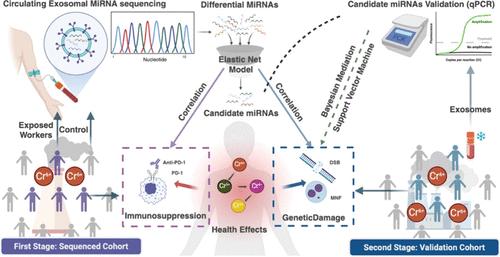当前位置:
X-MOL 学术
›
Environ. Sci. Technol.
›
论文详情
Our official English website, www.x-mol.net, welcomes your
feedback! (Note: you will need to create a separate account there.)
Exosomal miRNAs as Participators of Hexavalent Chromium-Induced Genotoxicity and Immunotoxicity: A Two-Stage Population Study
Environmental Science & Technology ( IF 10.8 ) Pub Date : 2024-11-20 , DOI: 10.1021/acs.est.4c06411 Shiyi Hong, Zekang Su, Yali Zhang, Guiping Hu, Qiaojian Zhang, Zhiqiang Ji, Li Wang, Shanfa Yu, Xiaojun Zhu, Fang Yuan, Guang Jia
Environmental Science & Technology ( IF 10.8 ) Pub Date : 2024-11-20 , DOI: 10.1021/acs.est.4c06411 Shiyi Hong, Zekang Su, Yali Zhang, Guiping Hu, Qiaojian Zhang, Zhiqiang Ji, Li Wang, Shanfa Yu, Xiaojun Zhu, Fang Yuan, Guang Jia

|
Genotoxic and immunosuppressive characteristics are central to the carcinogenic profile of hexavalent chromium [Cr(VI)], with dysregulation of circulating exosomal miRNA potentially acting as oncogenes or tumor suppressors or participating in the carcinogenic landscape of heavy metals through immunomodulation. In this two-stage epidemiological investigation, we unveiled for the first time the perturbations of exosomal miRNAs among individuals exposed to Cr(VI), alongside their significant correlations with biomarkers of genetic injury (γ-H2AX positivity in circulating lymphocytes and the urinary 8-OHdG levels) and immunological indicators (immunosuppressive PD-1 expression), which was supported by validation in an external cohort. Employing a support vector machine model, we discerned that exosomal miRNAs, particularly miR-4467, miR-345-5p, miR-144-3p, and miR-206, exhibited a remarkable capacity to delineate the genetic damage stratum within the population with high precision, and the target genes predicted of these miRNAs further elucidated their intricate regulatory interplay with the effector biomarkers. Additionally, employing a Bayesian mediation framework, we observed the intermediary function of miR-4467 in the nexus between chromium exposure and the escalation of urinary 8-OHdG levels (mediation effect: 0.47, P < 0.05). Although our findings suggested a link between extracellular miRNAs and immunosuppressive biomarkers, this association did not achieve validation in the external cohort, possibly due to population heterogeneity. Collectively, this study advanced our understanding of the epigenetic orchestration of health hazards of Cr(VI) by exosomal miRNAs, shedding light on their expression signatures and their intricate interplay with Cr(VI)-induced genetic and immunological perturbations, thus providing novel perspectives on the toxic pathways of heavy metals.
中文翻译:

外泌体 miRNA 作为六价铬诱导的遗传毒性和免疫毒性的参与者:一项两阶段群体研究
遗传毒性和免疫抑制特性是六价铬 [Cr(VI)] 致癌特征的核心,循环外泌体 miRNA 的失调可能充当致癌基因或肿瘤抑制因子,或通过免疫调节参与重金属的致癌景观。在这项两阶段的流行病学调查中,我们首次揭示了暴露于 Cr(VI) 的个体中外泌体 miRNA 的扰动,以及它们与遗传损伤生物标志物(循环淋巴细胞中的 γ-H2AX 阳性和尿液 8-OHdG 水平)和免疫学指标(免疫抑制性 PD-1 表达)的显着相关性,这在外部队列中得到了验证的支持。采用支持向量机模型,我们发现外泌体 miRNA,特别是 miR-4467、miR-345-5p、miR-144-3p 和 miR-206,表现出高精度描绘群体内遗传损伤层的显着能力,并且预测这些 miRNA 的靶基因进一步阐明了它们与效应生物标志物错综复杂的调节相互作用。此外,采用贝叶斯中介框架,我们观察到 miR-4467 在铬暴露与尿液 8-OHdG 水平升高之间的中介功能 (中介效应: 0.47,P < 0.05)。 尽管我们的研究结果表明细胞外 miRNA 与免疫抑制生物标志物之间存在联系,但这种关联并未在外部队列中得到验证,可能是由于群体异质性。 总的来说,这项研究推进了我们对外泌体 miRNA 对 Cr(VI) 健康危害的表观遗传编排的理解,阐明了它们的表达特征以及它们与 Cr(VI) 诱导的遗传和免疫扰动的复杂相互作用,从而为重金属的毒性途径提供了新的视角。
更新日期:2024-11-20
中文翻译:

外泌体 miRNA 作为六价铬诱导的遗传毒性和免疫毒性的参与者:一项两阶段群体研究
遗传毒性和免疫抑制特性是六价铬 [Cr(VI)] 致癌特征的核心,循环外泌体 miRNA 的失调可能充当致癌基因或肿瘤抑制因子,或通过免疫调节参与重金属的致癌景观。在这项两阶段的流行病学调查中,我们首次揭示了暴露于 Cr(VI) 的个体中外泌体 miRNA 的扰动,以及它们与遗传损伤生物标志物(循环淋巴细胞中的 γ-H2AX 阳性和尿液 8-OHdG 水平)和免疫学指标(免疫抑制性 PD-1 表达)的显着相关性,这在外部队列中得到了验证的支持。采用支持向量机模型,我们发现外泌体 miRNA,特别是 miR-4467、miR-345-5p、miR-144-3p 和 miR-206,表现出高精度描绘群体内遗传损伤层的显着能力,并且预测这些 miRNA 的靶基因进一步阐明了它们与效应生物标志物错综复杂的调节相互作用。此外,采用贝叶斯中介框架,我们观察到 miR-4467 在铬暴露与尿液 8-OHdG 水平升高之间的中介功能 (中介效应: 0.47,P < 0.05)。 尽管我们的研究结果表明细胞外 miRNA 与免疫抑制生物标志物之间存在联系,但这种关联并未在外部队列中得到验证,可能是由于群体异质性。 总的来说,这项研究推进了我们对外泌体 miRNA 对 Cr(VI) 健康危害的表观遗传编排的理解,阐明了它们的表达特征以及它们与 Cr(VI) 诱导的遗传和免疫扰动的复杂相互作用,从而为重金属的毒性途径提供了新的视角。


















































 京公网安备 11010802027423号
京公网安备 11010802027423号